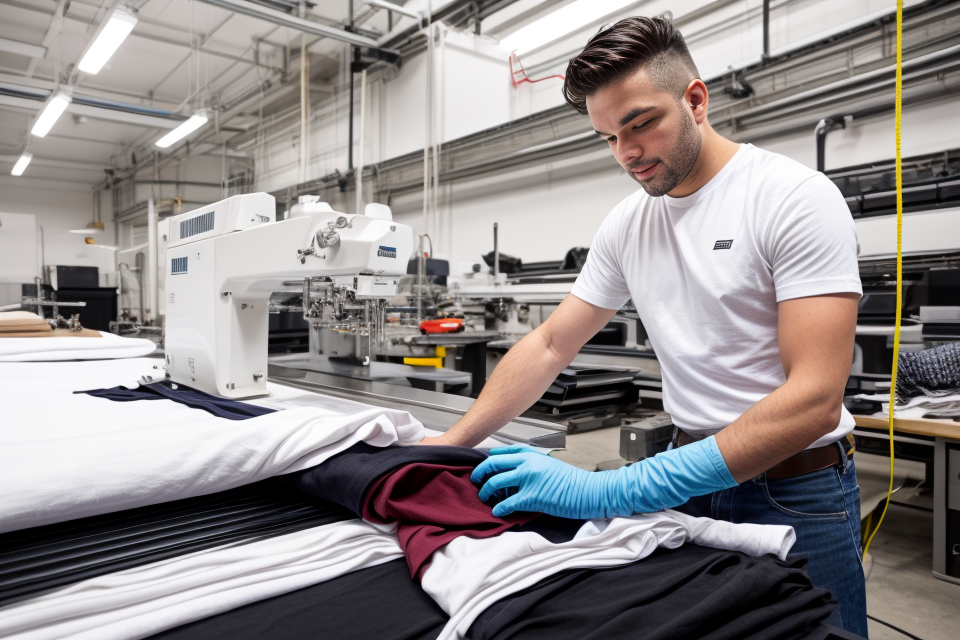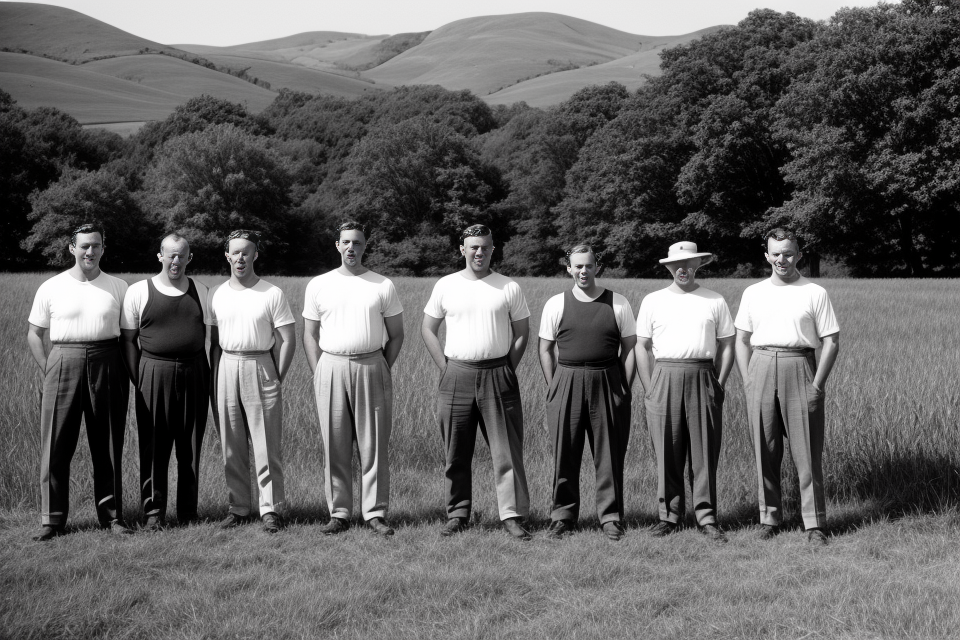T-shirts have become a staple in everyone’s wardrobe. They are versatile, comfortable, and can be worn on any occasion. But have you ever wondered how these simple garments are made? From the fabric selection to the final product, the process of making a T-shirt is a complex and intricate one. In this article, we will take a closer look at the step-by-step process of how T-shirts are made, from the raw materials to the finished product. So, let’s dive in and unveil the secrets behind the making of T-shirts.
Understanding the T-Shirt Manufacturing Process
The Cotton Journey: From Farm to Fabric
Growing Cotton
Cotton, a natural fiber, is primarily grown in tropical and subtropical regions, with the United States, China, and India being the top producers. The cotton plant is a shrub-like plant that can grow up to 6 feet tall and is usually harvested by a process called ginning.
Harvesting and Ginning
Cotton plants are harvested by either picking the cotton by hand or using a machine called a cotton picker. The cotton is then transported to a gin, where the seeds are removed from the cotton fibers through a process called ginning. The ginning process results in two main products: cotton fiber and cottonseed, which is used for oil production.
Carding and Spinning
After the cotton fibers have been separated from the seeds, they are further processed in a process called carding. Carding is a process of straightening and aligning the fibers, making them ready for spinning. In spinning, the cotton fibers are twisted together to create a yarn. This yarn can then be used to weave or knit fabric.
Weaving or Knitting
The final step in the process of creating cotton fabric is either weaving or knitting. Weaving is a process of interlacing threads in a vertical and horizontal pattern to create a fabric. Knitting, on the other hand, is a process of interlocking loops of yarn to create a fabric. The cotton yarn is then used to create a wide range of clothing items, including T-shirts.
Design and Artwork
Designing a t-shirt is a crucial step in the manufacturing process, as it sets the tone for the entire product. The design process typically involves several stages, starting with sketching and conceptualization and ending with printing and screen-printing.
Sketching and Conceptualization
The first step in the design process is sketching and conceptualization. This stage involves creating rough sketches of the t-shirt design, which can be hand-drawn or created using computer-aided design (CAD) software. The sketches are used to develop a concept or idea for the t-shirt design, which will be refined and finalized in later stages.
Digital Design
Once the concept has been developed, the design is digitized using computer software. This allows the design to be scaled up or down, modified, and adjusted for color and other visual elements. Digital design software also enables designers to create intricate patterns and graphics that would be difficult or impossible to create by hand.
Printing and Screen-Printing
After the design has been digitized, it is ready for printing. The most common method of printing t-shirts is screen-printing, which involves using a screen to transfer ink onto the fabric. The design is printed onto a screen, which is then pressed onto the t-shirt using a squeegee. The screen is then removed, leaving the design on the t-shirt. This process is repeated for each color in the design, resulting in a multi-colored t-shirt.
Overall, the design and artwork stage of the t-shirt manufacturing process is a crucial step that sets the tone for the entire product. It involves sketching and conceptualization, digital design, and printing and screen-printing, all of which are essential to creating a high-quality t-shirt.
Cutting and Sewing
Pattern Making
Before cutting the fabric, the manufacturer needs to create a pattern that will serve as a guide for cutting the T-shirt. This pattern is usually made of paper or cardboard and is based on the specific design and size of the T-shirt. The pattern will have markings for the armholes, neckline, and hemline, which will be used to cut the fabric.
Cutting Fabric
Once the pattern has been created, the manufacturer can begin cutting the fabric. The fabric is laid out on a table, and the pattern is placed on top of it. Using scissors or a cutter, the manufacturer will cut the fabric according to the markings on the pattern. This process is known as cutting the fabric, and it is a crucial step in the manufacturing process.
Sewing the T-Shirt
After the fabric has been cut, the manufacturer can begin sewing the T-shirt together. The sewing process involves taking the different pieces of the T-shirt and sewing them together using a sewing machine. The sewing machine is programmed with the specific stitch pattern and sewing speed, which will be used to sew the T-shirt together.
Once the T-shirt has been sewn together, it is time to move on to the next step in the manufacturing process, which is usually finishing the T-shirt. This can include processes such as printing designs or logos on the T-shirt, attaching labels or tags, and performing any final quality control checks.
Quality Control and Packaging
Once the t-shirts have been produced, they undergo a rigorous quality control process to ensure that they meet the required standards. This process involves several stages, including inspection, quality control, and packaging.
Inspection and Quality Control
The first step in the quality control process is to inspect the t-shirts for any defects or imperfections. This inspection is carried out by trained quality control professionals who check each t-shirt for any stains, tears, or other issues that may affect its quality.
If any defects are found, the t-shirt is rejected and sent back for further processing or discarded. This ensures that only high-quality t-shirts reach the market.
The next step in the quality control process is to test the t-shirts for their durability and resistance to wear and tear. This involves subjecting the t-shirts to various tests, such as washing, drying, and ironing, to ensure that they maintain their shape and color over time.
If the t-shirts pass these tests, they are considered to be of high quality and are ready for packaging.
Packaging and Labeling
Once the t-shirts have been inspected and tested for quality, they are packaged and labeled for distribution. The packaging process involves placing the t-shirts in plastic bags or boxes to protect them from damage during transportation.
The labeling process involves affixing labels to the t-shirts that provide information about the product, such as its size, color, and care instructions. These labels are usually attached to the t-shirt’s neckline or sleeve.
The packaging and labeling process is important as it helps to ensure that the t-shirts are presented in an attractive and professional manner, which can enhance their appeal to customers.
Overall, the quality control and packaging process is a critical part of the t-shirt manufacturing process. It ensures that only high-quality t-shirts reach the market, and that they are presented in an attractive and professional manner.
Shipping and Distribution
The process of shipping and distribution is a crucial step in the manufacturing of t-shirts. This involves the transportation of finished garments from the factory to the retailers or customers. The following are the key aspects of shipping and distribution in t-shirt manufacturing:
Transportation and logistics
The transportation of t-shirts from the factory to the customers involves a well-planned logistics system. This includes the selection of the most efficient and cost-effective mode of transportation, such as air, sea, or land freight. The logistics team must also ensure that the t-shirts are transported in a safe and secure manner to prevent any damage during transit.
Additionally, the logistics team must coordinate with the retailers or customers to ensure that the t-shirts are delivered to the right location at the right time. This involves the use of sophisticated tracking systems that allow the team to monitor the movement of the t-shirts in real-time.
Distribution channels
The distribution channels for t-shirts can vary depending on the target market. For example, t-shirts may be sold through online retailers, brick-and-mortar stores, or through a network of wholesalers and distributors.
The distribution channel selected will depend on various factors, such as the target market, the volume of t-shirts to be sold, and the cost of distribution. Online retailers, for instance, offer a convenient and cost-effective way to reach a large audience, while brick-and-mortar stores provide a more personal shopping experience.
In conclusion, the shipping and distribution process is a critical step in the manufacturing of t-shirts. It involves the transportation of finished garments from the factory to the customers, and the use of logistics systems to ensure that the t-shirts are delivered safely and securely. The distribution channels selected will depend on various factors, such as the target market and the volume of t-shirts to be sold.
Environmental Impact and Sustainability
Water and Energy Consumption
The manufacturing of t-shirts requires a significant amount of water and energy. In fact, it takes approximately 700 gallons of water to produce a single t-shirt, from growing the cotton to dyeing and cutting the fabric. This is an alarming statistic, especially considering that many parts of the world face water scarcity. Additionally, the energy required to power the machinery used in the manufacturing process contributes to greenhouse gas emissions and climate change.
Recycling and Upcycling
To mitigate the environmental impact of t-shirt production, recycling and upcycling have become increasingly popular. Recycling involves breaking down old t-shirts and using the fabric to create new garments, reducing the need for virgin materials. Upcycling, on the other hand, involves transforming old t-shirts into new, unique pieces, rather than breaking them down completely. Both practices help to reduce waste and conserve resources.
Eco-friendly Alternatives
In recent years, there has been a push towards more sustainable and eco-friendly alternatives to traditional cotton t-shirts. For example, organic cotton is grown without the use of harmful pesticides and synthetic fertilizers, reducing the negative impact on the environment. Additionally, there are now t-shirts made from bamboo, hemp, and even recycled plastic bottles, providing viable alternatives to traditional cotton. These eco-friendly options not only reduce the environmental impact of t-shirt production, but also offer consumers a more sustainable choice when it comes to their wardrobe.
Tips for a Smooth T-Shirt Production Process
Producing t-shirts can be a complex process, but with proper planning and preparation, you can ensure a smooth production process. Here are some tips to help you achieve this:
Proper Planning and Preparation
The first step in producing t-shirts is to have a clear plan and preparation. This includes having a clear understanding of your target market, the design you want to use, and the materials you will need. It is also important to have a timeline for production and delivery to ensure that you meet your deadlines.
Choosing the Right Materials and Suppliers
Choosing the right materials and suppliers is crucial to the success of your t-shirt production process. You should research different types of fabrics and suppliers to ensure that you are using high-quality materials that will produce the best results. Additionally, it is important to establish good relationships with your suppliers to ensure that you receive the best service and pricing.
Investing in Modern Technology
Investing in modern technology can greatly improve the efficiency and quality of your t-shirt production process. This includes using software to streamline the design process, automating tasks such as cutting and sewing, and using digital printing methods. By using technology, you can produce t-shirts faster and with higher quality.
Quality Control Measures
Quality control measures are essential to ensure that your t-shirts meet the highest standards. This includes inspecting the materials and finished products for defects, as well as testing the durability and colorfastness of the t-shirts. By implementing quality control measures, you can ensure that your t-shirts are of the highest quality and will meet the needs of your customers.
Overall, by following these tips, you can ensure a smooth t-shirt production process that will result in high-quality products that meet the needs of your customers.
FAQs
1. What are the steps involved in making a T-shirt?
The process of making a T-shirt involves several steps, including designing the print or pattern, cutting the fabric, sewing the pieces together, and adding any additional features such as sleeves or a hood. The specific steps can vary depending on the type of T-shirt being made and the equipment and materials available.
2. What type of fabric is used to make T-shirts?
The most common type of fabric used to make T-shirts is a lightweight, breathable fabric such as cotton or a cotton-polyester blend. Other materials that may be used include bamboo, silk, and synthetic fabrics like polyester or nylon. The choice of fabric will depend on the desired look, feel, and durability of the T-shirt.
3. How is the design printed or embroidered on the T-shirt?
There are several methods for printing or embroidering a design on a T-shirt, including screen printing, digital printing, and embroidery. Screen printing involves using a stencil and ink to transfer the design onto the fabric, while digital printing uses a printer to produce a high-resolution image. Embroidery involves stitching the design onto the fabric using a needle and thread.
4. What are the different types of T-shirts that can be made?
There are many different types of T-shirts that can be made, including basic solid-color T-shirts, T-shirts with printed or embroidered designs, T-shirts with a hood or a pocket, and T-shirts with a unique fit or style. Some T-shirts may also have special features such as moisture-wicking technology or UV protection.
5. How can I make my own T-shirt at home?
Making a T-shirt at home can be a fun and rewarding project. You will need some basic supplies such as fabric, scissors, a sewing machine, and any additional features you want to add (such as sleeves or a hood). You can find tutorials online that will walk you through the process step by step, or you can use a T-shirt kit that includes pre-cut pieces and instructions. With a little bit of time and effort, you can create a one-of-a-kind T-shirt that you can wear with pride.



